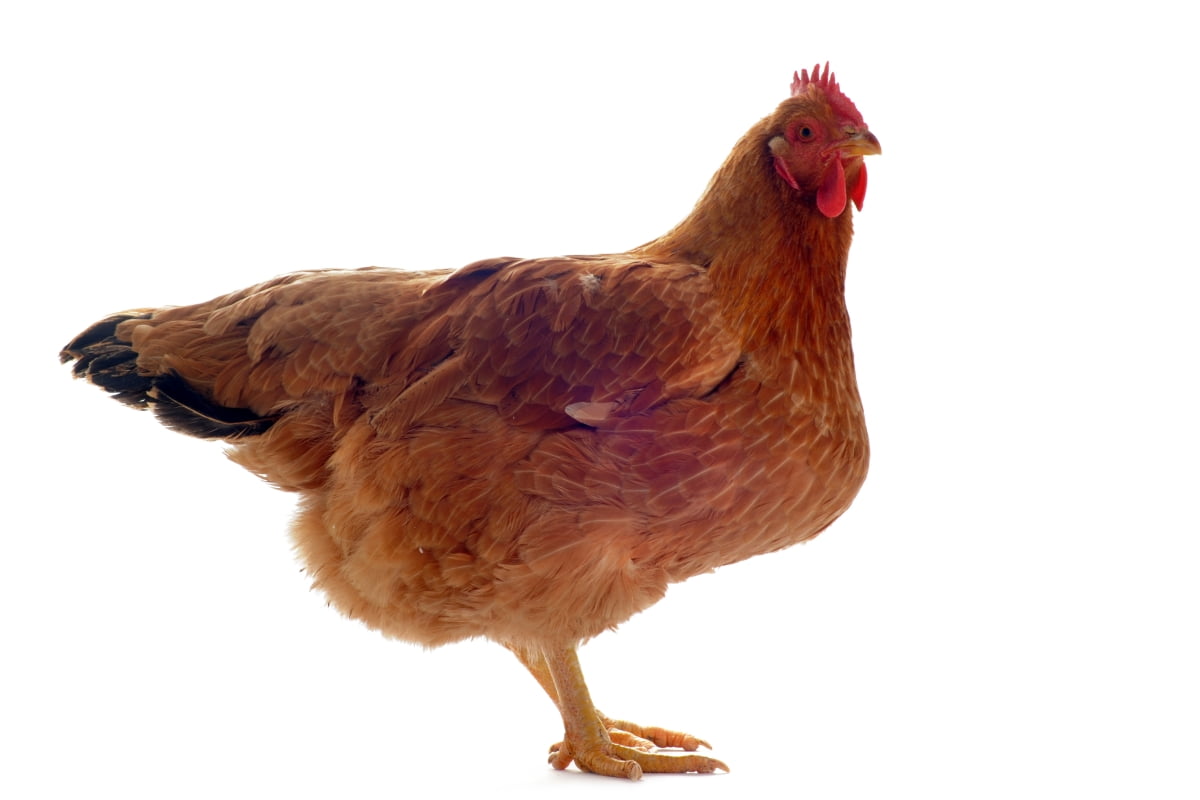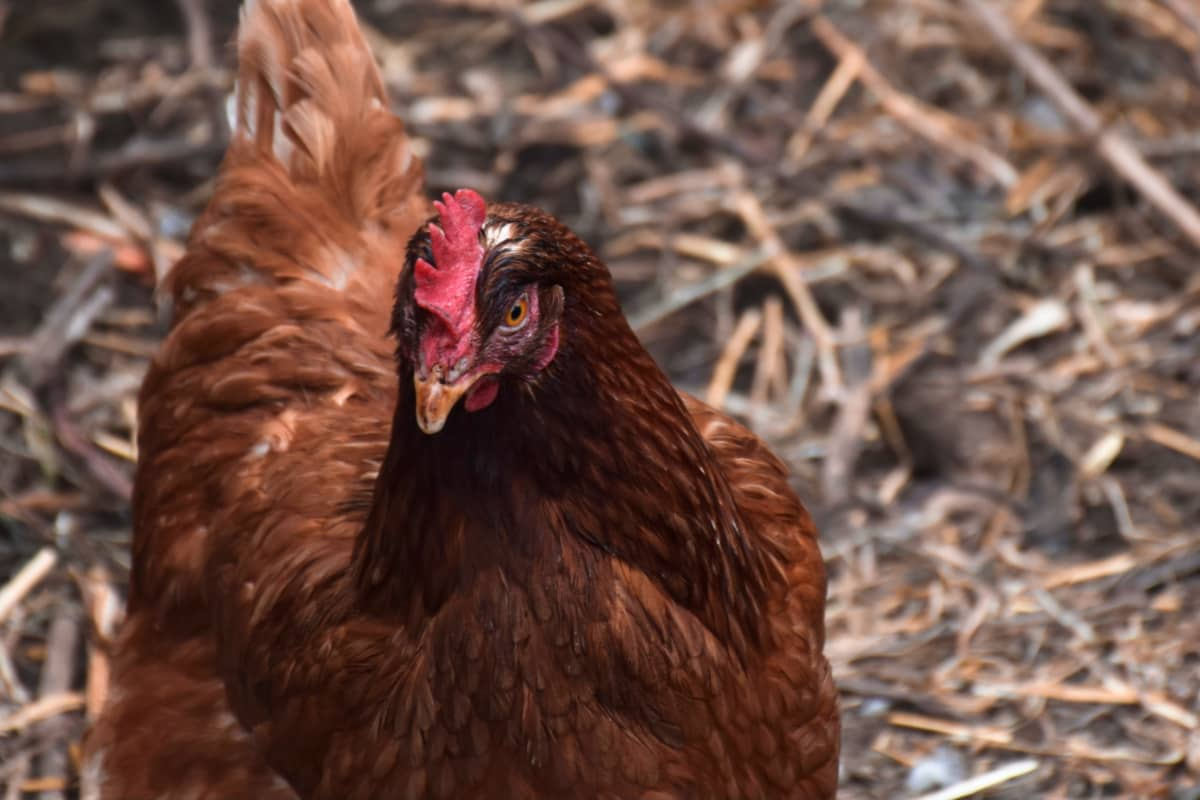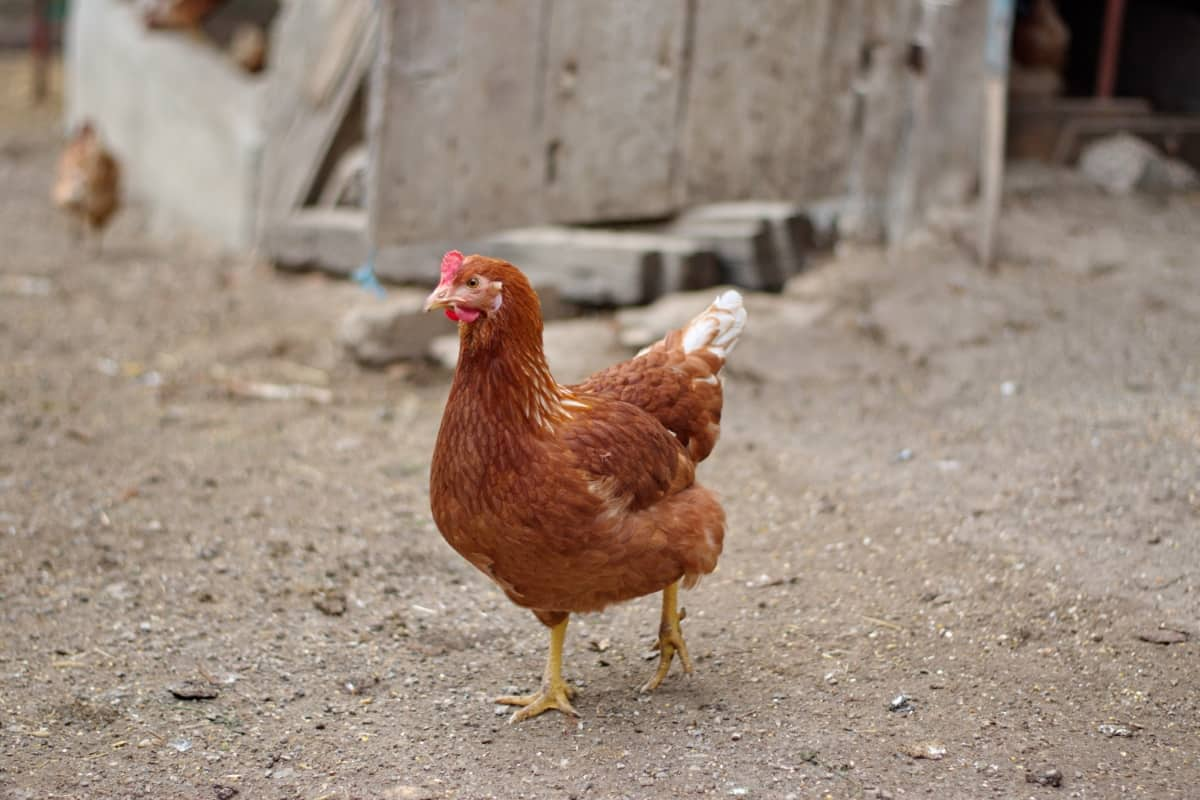Buckeye chickens, named after Ohio’s state tree, originated in the late 19th century. Created by Nettie Metcalf, they’re America’s only chicken breed created by a woman. Crossbreeding several breeds, including Barred Plymouth Rocks and Buff Cochins, Metcalf aimed to develop a hardy, dual-purpose bird adaptable to Ohio’s climate. American Poultry Association recognized in 1904 that Buckeyes were initially bred for eggs and meat, though their popularity declined over time.

All You Need to Know About Buckeye Chicken
Buckeye Chicken Breed Characteristics and Appearance
- Buckeyes boast stunning mahogany-red plumage with black tails and a distinct pea comb.
- Buckeye chicken color: Dark, reddish-brown in color, and glossy in texture.
- Buckeye chicken size: They’re medium-sized birds, with hens typically weighing around 2.7-3.2 kg and roosters ranging from 3.2-4.1 kg.
- Their sturdy build and upright carriage give them an imposing presence in any flock.
- Buckeye chicken lifespan: 8-10 Years
Buckeye Chicken Price
Buckeye chickens are moderately priced, typically ranging from $5 to $20 per chick, depending on the source, age, and breeding quality. Adult birds can be found for around $20 to $50 each. These prices may vary based on location, breeder reputation, and availability.
Choosing Your Buckeye Chickens
Selecting Healthy Birds
When Breeding Buckeye chickens, choose chickens with bright eyes, clean feathers, and active behavior. Avoid birds with signs of illness, such as lethargy or discharge. Check for well-developed combs and legs, indicating good health and vigor.
Understanding Breed Variations
While Buckeyes generally adhere to breed standards, there may be variations in color intensity and size due to individual genetics and breeding practices. Some may exhibit slightly lighter or darker plumage, but overall, they should maintain the characteristic mahogany-red color and sturdy build.
Housing and Environment
Best Coop Designs for Buckeye Chickens
Construct a coop that provides ample space for your Buckeye chickens to move around comfortably. Ensure it is well-insulated, predator-proof, and has proper ventilation. Include roosting bars and nesting boxes for laying eggs. Provide clean bedding material with straw or wood shavings to maintain hygiene and comfort.
Ensuring Proper Ventilation and Space
Install windows or vents to allow for adequate airflow within the coop. Good ventilation helps regulate temperature, prevent moisture buildup, and reduce the risk of respiratory issues. Provide at least 4 square feet of indoor space per bird, along with outdoor access for foraging and exercise.
Feeding and Nutrition for Buckeye Chickens
Basic Nutritional Requirements
How to feed Buckeye chickens? Buckeye chickens require a balanced diet consisting of high-quality poultry feed. Ensure the feed contains adequate levels of protein (around 16-20%), vitamins, and minerals to support growth, egg production, and overall health. Fresh, clean water should be available at all times.
Supplements and Treats for Optimal Health
In addition to commercial feed, consider supplementing your Buckeye chickens’ diet with treats such as fruits, vegetables, and mealworms. These treats provide additional nutrients and serve as enrichment for the birds. Offer calcium supplements, such as crushed oyster shells, to support strong eggshells in laying hens. However, treats should only constitute a small portion of their diet to maintain nutritional balance.
In case you missed it: Bionda Piemontese Chicken Facts: Ultimate Guide Breeding, Raising and Care

Buckeye Chickens Health Management
Common Health Issues and Prevention
Buckeye chickens are generally robust and resilient but may be susceptible to common poultry ailments such as respiratory infections, parasites (such as mites and worms), and reproductive issues. Preventive measures include maintaining a clean coop, providing proper nutrition, regular health checks, and promptly addressing any signs of illness. Practice biosecurity to minimize the risk of disease transmission.
Regular Health Checks and Vaccination
Perform routine health checks on your Buckeye chickens, monitoring for signs of illness or injury. Vaccinate against common poultry diseases such as Marek’s disease, Newcastle disease, and infectious bronchitis to bolster their immune systems and for preventing diseases in Buckeye chickens. Consult with a veterinarian in poultry care for guidance on the Buckeye chicken vaccination schedule and health management.
Buckeye Chicken Behavior and Temperament
Social Behaviors and Compatibility
Buckeye chickens are known for their calm and friendly temperament, making them excellent additions to backyard flocks. They typically get along well with other chicken breeds and are adaptable to various social dynamics within the flock. Provide adequate space and resources to minimize competition and aggression among birds.
Handling and Reducing Stress
Handle Buckeye chickens gently and calmly to build trust and minimize stress. Avoid sudden movements or loud noises. Provide enrichments such as perches, dust bathing areas, and environmental stimuli to alleviate boredom and reduce stress levels. Minimize disruptions to their routine and environment to maintain their overall well-being. Regularly observe their behavior for any signs of distress and address any underlying causes promptly.
Egg Production
Expectations and Maximizing Output
Buckeye chickens are moderate egg layers, typically producing around 150-200 per year. The buckeye chicken egg color is brown. To maximize buckeye chicken egg production, ensure they receive a balanced diet, sufficient daylight (at least 14 hours), and access to clean nesting boxes. Minimize stressors and provide a comfortable environment. Select breeding stock from lines known for consistent egg production. While not prolific layers like some breeds, Buckeyes can still provide a steady supply of nutritious eggs for your household.
Egg Collection and Storage Practices
Daily collect eggs to prevent them from becoming soiled or damaged. Handle eggs gently to avoid cracks or breakage. Store collected eggs in a cool and dry place, and they should be away from sunlight and strong odors. Use a designated egg carton or storage container to keep them organized and prevent contamination. Properly refrigerated, Buckeye eggs can maintain freshness for several weeks. Regularly rotate eggs to ensure even distribution of storage time.
Breeding Buckeye Chickens
Breeding Basics and Strategies
Choose breeding stock with desirable traits such as good health, temperament, and adherence to breed standards. Practice selective breeding to maintain or improve these characteristics in offspring. Avoid inbreeding by periodically introducing new bloodlines. Monitor mating behavior and fertility rates to ensure successful breeding outcomes.
Managing the Breeding Flock
Maintain a healthy and balanced breeding flock by providing optimal nutrition, clean housing, and regular health checks. Monitor breeding pairs for compatibility and reproductive success. Rotate breeding males periodically to prevent overbreeding and ensure genetic diversity. Keep detailed records of breeding outcomes to inform future breeding decisions and track progress toward breeding goals.
In case you missed it: Homemade Feed Formulations for Chickens: Cost-Effective Starter to Finisher Feed Recipes

Raising Baby Chickens
Incubation and Hatching Tips
For hatching Buckeye chicks, maintain consistent temperature (around 37-38°C) and humidity levels (around 50-60%) throughout the incubation period. Turn the Buckeye chicken eggs regularly to prevent embryo adherence to the shell. Monitor egg development using a candler to check for viability. Provide a clean and warm brooder area for newly hatched chicks, with access to fresh water and chick starter feed.
Care and Feeding of Young Chickens
After hatching, provide a draft-free brooder environment with a heat lamp to maintain temperatures around 35°C for the first week, gradually decreasing by 2.8°C each week until chicks are fully feathered. Offer chick starter feed formulated specifically for young poultry, along with fresh water at all times. Monitor chick behavior and health closely, addressing any issues promptly. Provide enrichment such as perches or pecking objects to encourage natural behaviors and development.
In case you missed it: Top 10 Fluffy Chicken Breeds to Raise in Your Backyard

Conclusion
Raising Buckeye chickens offers a rewarding experience for poultry enthusiasts. From their historic origins to their unique characteristics, Buckeyes bring charm and productivity to any flock. By Buckeye chickens care guide, nutrition, and breeding practices, you can enjoy the companionship of these hardy birds while reaping the benefits of their eggs and meat. Embrace the journey of raising Buckeye chickens and enjoy the bountiful rewards they bring to your homestead.
Note: The images presented in this post are intended solely for representation purposes. The images are meant to serve as visual aids and should not be relied upon as accurate representations of their real-life counterparts.
- Feed Your Flock for Less: Top 10 Tips to Save on Chicken Feed
- Ultimate Guide to Ossabaw Island Hog: Breeding, Raising, Diet, and Care
- Hatching Answers: The Top 10 Reasons Your Chickens Aren’t Laying Eggs
- Eggs and Economics: Breaking Down the Cost of Raising Backyard Chickens
- Defend Your Greens: Proven Methods to Keep Iguanas Out of Your Garden
- Ultimate Guide to Cinnamon Queen Chicken: A Comprehensive Guide for Beginners
- Ultimate Guide to California Tan Chicken: Breeding, Raising, Diet, Egg-Production and Care
- Ultimate Guide to Marsh Daisy Chicken: Breeding, Raising, Diet, and Care
- 10 Types of Chicken Farming Businesses You Can Start for Profits